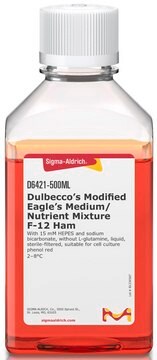D5671
DMEM - high glucose
With sodium Bicarbonate, without ʟ-glutamine and sodium pyruvate, liquid, sterile-filtered, suitable for cell culture
Synonym(s):
DME, Dulbecco′s Modified Eagle′s Medium - high glucose, DMEM
About This Item
Recommended Products
product name
Dulbecco′s Modified Eagle′s Medium - high glucose, With 4500 mg/L glucose and sodium bicarbonate, without L-glutamine and sodium pyruvate, liquid, sterile-filtered, suitable for cell culture, suitable for hybridoma
Quality Level
sterility
sterile-filtered
form
liquid
technique(s)
cell culture | hybridoma: suitable
cell culture | mammalian: suitable
impurities
endotoxin, tested
components
L-glutamine: no
glucose: high
NaHCO3: yes
sodium pyruvate: no
phenol red: yes
HEPES: no
shipped in
ambient
storage temp.
2-8°C
Looking for similar products? Visit Product Comparison Guide
General description
Application
Reconstitution
also commonly purchased with this product
related product
Storage Class Code
12 - Non Combustible Liquids
WGK
WGK 1
Flash Point(F)
Not applicable
Flash Point(C)
Not applicable
Certificates of Analysis (COA)
Search for Certificates of Analysis (COA) by entering the products Lot/Batch Number. Lot and Batch Numbers can be found on a product’s label following the words ‘Lot’ or ‘Batch’.
Already Own This Product?
Find documentation for the products that you have recently purchased in the Document Library.
Customers Also Viewed
Articles
High titer lentiviral particles for LC3 variants used for live cell analysis of cellular autophagy.
High titer lentiviral particles including beta-actin, alpha-tubulin and vimentin used for live cell analysis of cytoskeleton structure proteins.
Protocols
This detailed procedure allows you to transduce Mouse Embryonic Fibroblasts (MEF) using MISSION ExpressMag Super Magnetic Kit.
Protocol Guide: XTT Assay for Cell Viability and Proliferation
MTT assay protocol for measuring cell viability, proliferation and cytotoxicity. Instructions for MTT reagent preparation and examples of applications.
Our team of scientists has experience in all areas of research including Life Science, Material Science, Chemical Synthesis, Chromatography, Analytical and many others.
Contact Technical Service







